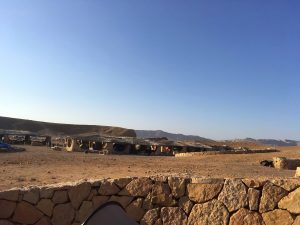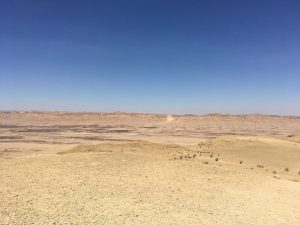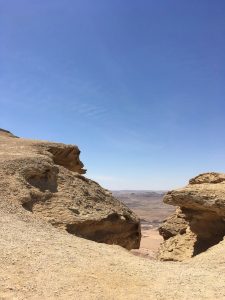Everything started with the attendance of the Minerva meeting 2017 in Israel – interesting talks, interesting people, interesting culture to discover. After the end of the meeting we decided to spend some more days in Israel and discover something completely different.

Campground Beerot Khan: starting point of our hiking tour (photo by J. Daßler)
You have probably thought that people travel to Israel – despite attending a meeting – due to religious motivations or to eat falafel? Ever heard about the Negev desert? The origin of the word negev comes from the Hebrew and has the meaning ‘dry’. The Negev desert covers more than the half of Israel and is delimited in the north by Beersheba and in the south by the Gulf of Aqaba.
But enough about geographical facts. What are people doing in this harsh, unforgiving and rocky desert with sparse vegetation and only about 10 mm of rain every year? This science-fiction like area is crossed with some of the greatest hiking trails in the Middle East. Moreover, the Ramon Crater is one of the Negev desert’s most famous geological features. The crater is not – as it is often mistakenly believed – the result of a meteor impact nor a volcanic crater but instead the world’s largest erosion crater: 40 km in length, between 2-10 km in width and 500 meters depth.

Ramon Crater (photo by J. Daßler)
Ramon Crater – especially Mount Ardon- was the place where we scientists started to discover Israel from another point of view. Blazing heat, the sun hits the dusty track near the campground Beerot Khan while four scientists started to prepare to ascent Mount Ardon. With a headgear, a backpack, enough water and a lot of sun blocker in our faces we started our trip. It was crazy and we needed time to get used to the hot temperatures on our hiking tour. We started into the wideness of an infinite cliffy landscape with mysterious and old rocks arranged to impressive formations. It was a real adventure. Mt. Ardon was the dominating cliff ahead of us to the North. After approximately half an hour walk we noticed that the rock and sand below our feet gradually changed from black to red to yellow to white .. Now the challenging part of the 11 km round-hiking tour was in front of us. We took a deep breath at the bottom of the mountain and started to climb up the steep side. You should not try to climb up the mountain if you have any fears regarding heights and unpaved stony trails. For me it was tough: in the middle of the climb I got a panic attack but returning was no option. So the answer was: climb on. I arrived at the top but it took me some minutes to realize that the hike enters its second and more relaxing phase: crossing the Mount Ardon Plateau and the summit of Mount Ardon itself. The top of Mount Ardon is actually the center of the crater, meaning a breathtaking view of rainbow sands from the summit. In the end we enjoyed the adrenalin of the climb up and the view was brilliant.

Breathtaking view of rainbow sands on the top of Mount Ardon (photo by J. Daßler)
We had a great picnic (fig spread is so delicious!), chatted about the experience of the climb and took a lot of pictures. We followed the trail along the rim and were once again rewarded with an amazing viewpoint. We realized a lot of bird life on the top, such as vulture and ravens living in the limestone cliffs of the crater. Finally, we entered the third-phase of a steep descent back into the crater. Though the path is well marked, the surface is decidedly loose and one false step is likely to result in an excruciatingly painful ankle, if not worse. I did quasi-mathematical calculations step by step to ensure to get down safely. We came down the mountain from the other side and passed Wadi Ardon to get back to our starting point.
In the end we passed 261 m of altitude, drunk approximately 3 liters of water each, faced our fears and managed this exhilarating climb to the top of the cliff in the middle of the heart of the Ramon Crater. If you ever have the chance to visit Israel either while attending a meeting or as a tourist never forget about the stark beauty of Israel!
Juliane Daßler
